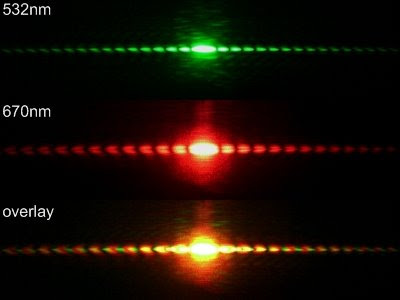

The amplitude of light on the card is then the integral
REFLECTIVE LASER DIFFRACTION IMAGE TV
Assuming that the pattern on the TV has a sinusoidal pattern of wavelength, the light on the card a distance away is formed from the superposition of many wavefronts reflected from across the width of the laser beam : Perhaps some structure in the matte plastic coating in front of the display? If anyone has an idea, please mention in the comments.įor the sake of completeness, we can also derive what we expected the diffracted light to look like, under a set of simplifying assumptions. This is far too small, by a factor of 100, to be caused by the pixels (did I mention the TV is really big?), so must be caused by something else. I was standing around 35cm from the TV screen for these photos, which plugging in to the above means the diagonal structures are around 5 microns in size. The standard equation for diffraction gratings states that the angle of the diffracted light depends on the wavelength and the grating period through If I plot the image intensity along a diagonal line through the two spots, it looks like: Nice font for plots, don’t you think? The circle marks a radius of 36mm from the centre of the diffraction pattern, and shows that the four spots diffract at the same angle. To correct for this, I applied a a projective transformation to the image to flatten it out as if the picture had been taken on-axis: The font is DIN Alternate Bold for those curious few. Without a willing assistant in my endeavours, I only managed to take pictures at an oblique angle. Because the laser light is (approximately) monochromatic, we get diffracted dots rather than streaks. Those 4 dots around the edges correspond to the diffracted streaks in the original image. I cobbled together, after finding some card, sellotape and blu-tack, the following: One polariser is missing, and the marks correspond to centimetre offsets.Īfter shining my contraption on the TV, I snapped several images like this: For an experimental physicist, I am really bad at holding things steady. The configuration I imagined was something like this: Sadly this diagram is superior to many setup drawings in scientific papers. To get a more accurate measurement of the diffraction angles, I needed to know the displacement of the reflected light relative to the incoming light. Two small pieces cut from each lens, arranged appropriately, and I had a homemade variable attenuator for my laser pen.

Now I’m not exactly sure which polarisers are in 3D glasses you get from the cinema (hello future blog post), but I do know that if you turn a second pair backwards and rotate them it’s possible to drastically cut light transmission. I don’t keep that many polarisers around in my flat, until I remembered I had 3D glasses by the dozen. If the polarisers are rotated relative to one another the total fraction of light transmitted through them can be substantially reduced. When we need to attenuate a laser in the lab, one method is to use a set of polarisers.

I’m shining it at a black diffuse reflector (neck pillow) so that the spot doesn’t completely blind the camera.Ī high power laser pointer! As someone who works with properly high power lasers on a frequent basis, I knew that it wasn’t safe to be playing with a CW (constant-wave) laser of this power, especially when there are specular reflections from smooth surfaces involved. Luckily for me, I’d recently acquired this beastie: Premium Shenzhen-grade probably-legal laser pointer. I wanted to measure this more precisely, without relying on knowing any details of the lens and CCD in my phone camera. Geometry for the diffraction effects observed in the photo above. The camera lens then maps diffraction angles to positions on the camera CCD. In this case fine structures in the TV screen are causing the reflected flash light to diffract. This kind of device is known as a diffraction grating, used extensively in experiments to split a light source up into different frequency components. Furthermore, red wavelengths are deflected outwards to greater angles, causing the light to be spectrally dispersed in the reflection. However some light is reflected back at an angle, causing it to appear displaced from the centre of the image. Most of the light from the flash is reflected straight back, causing the white region in the centre of the image. Did I mention it’s curved? Yeah it’s totally curved. The picture in question was this: Reflection of a camera flash from my new TV. Here’s a little write-up of my DIY measurements. Fortuitously, I had also recently bought a slightly too-powerful laser pointer from China which is the perfect tool to investigate such problems. When taking a picture of my new 55″ TV (humblebrag) I noticed a diffraction pattern of the reflection of the camera flash.


 0 kommentar(er)
0 kommentar(er)
